
Echinacea angustifolia, the narrow-leaved purple coneflower or blacksamson echinacea, is a species of flowering plant in the family Asteraceae. It is native to North America, where it is widespread across much of the Great Plains of central Canada and the central United States, with additional populations in surrounding regions.
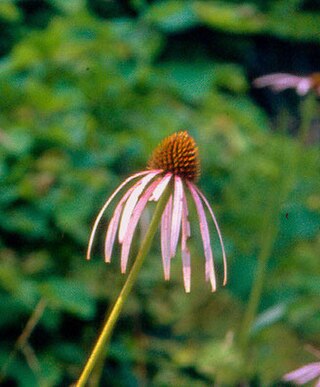
Echinacea laevigata, the smooth purple coneflower, is a federally listed threatened species of plant found in the Piedmont of the eastern United States. Most populations are found on roadsides and other open areas with plenty of sunlight, often on calcium- and magnesium- rich soils.
Hymenoxys cooperi is a species of flowering plant in the daisy family known by the common name Cooper's rubberweed. It is native to the southwestern United States and Great Basin, where it grows in rocky soils in arid regions from southern California to New Mexico, north as far as Idaho and Oregon.

Hymenoxys lemmonii is a species of flowering plant in the daisy family known by the common names Lemmon's rubberweed, Lemmon's bitterweed, and alkali hymenoxys. It is native to the western United States in and around the Great Basin in Utah, Nevada, northern California, and southeastern Oregon.

Hymenoxys odorata is a species of flowering plant in the daisy family known by the common names bitter rubberweed and western bitterweed. It is native to the southwestern and south-central United States from southern California to Texas north as far as Kansas and Colorado, as well as northern Mexico. It grows in dry regions.

Layia carnosa is a species of flowering plant in the family Asteraceae known by the common name beach tidytips, or beach layia. It is endemic to California, where it lives in coastal habitat. It is known from several areas of mostly fragmented or relict sand dune habitat, and it was listed as an endangered species in California. On March 31, 2022, the category was changed from endangered species to threatened species by the US Department of the Interior Fish and Wildlife Service.

Lessingia germanorum is a rare species of flowering plant in the family Asteraceae known by the common name San Francisco lessingia. It is endemic to California, where it is known from four populations in the Presidio of San Francisco and one occurrence on San Bruno Mountain south of San Francisco. It is a state and federally listed endangered species. The already rare plant is endangered by many processes, including invasive species, development, sand mining, off-road vehicles and bulldozers, habitat fragmentation, trampling, and pollution, as well as stochastic events.

Dalea foliosa, commonly called leafy prairie clover, is a species of flowering plant in the legume family (Fabaceae). It is an endangered species in the United States, where it occurs in three states: Illinois, Tennessee, and Alabama.
Pseudobahia bahiifolia is a rare species of flowering plant in the family Asteraceae known by the common name Hartweg's golden sunburst.
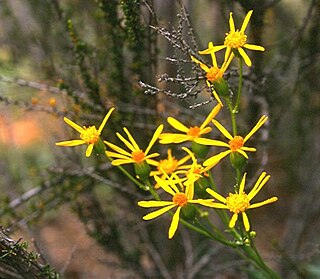
Packera layneae, known by the common name Layne's ragwort and Layne's butterweed, is a rare species of flowering plant in the aster family.

Erigeron maniopotamicus is a rare species of flowering plant in the family Asteraceae known by the common name Mad River fleabane. It is endemic to northwestern California, where it is known from only four locations in Humboldt and Trinity Counties.

Erigeron decumbens is a species of flowering plant in the family Asteraceae known by the common names Willamette fleabane or Willamette daisy. It is native to Oregon and California in the United States.
Thymophylla tephroleuca is a rare species of flowering plant known by the common names ashy pricklyleaf and ashy dogweed. It is endemic to Texas in the United States, where it occurs in two counties near the Mexican border. It became rare due to the destruction and degradation of its habitat. It is a federally listed endangered species of the United States.
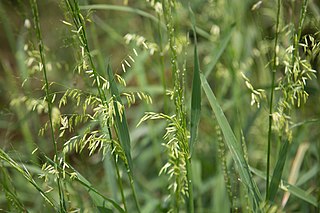
Zizania texana is a rare species of grass known by the common name Texas wild rice. It is endemic to Texas, where it is found only on the upper San Marcos River in Hays County. It is threatened by the loss and degradation of its habitat. It is a federally listed endangered species of the United States.

Solidago missouriensis is a species of flowering plant in the family Asteraceae known by the common names Missouri goldenrod and prairie goldenrod. It is native to North America, where it is widespread across much of Canada, the United States, and northern Mexico. It grows from British Columbia east to Manitoba, south as far as Sonora, Coahuila, Texas, and Mississippi.
Chloris texensis is a species of grass known by the common name Texas windmill grass. It is endemic to Texas in the United States, where it occurs on the coastal prairies.
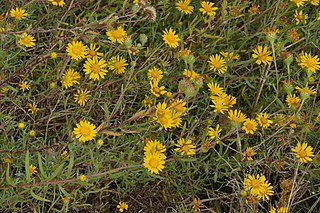
Rayjacksonia aurea is a species of flowering plant in the family Asteraceae known by the common names Houston tansyaster and Houston camphor daisy. It is endemic to Texas in the United States, where it is known only from the Houston area. It is limited to Galveston and Harris Counties.
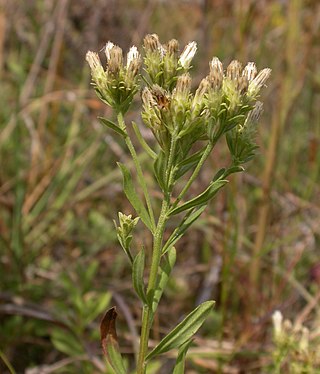
Sericocarpus rigidus is a species of flowering plant in the family Asteraceae known by the common name Columbian whitetop aster. It is native to the Pacific Northwest of North America, where it is known from southern Vancouver Island in British Columbia south along the coast to Washington and Oregon.

Tetraneuris acaulis is a North American species of flowering plants in the sunflower family. It is known by many common names in English including stemless four-nerve daisy, stemless hymenoxys, butte marigold, and stemless rubberweed.

Symphyotrichum estesii is a species of flowering plant in the family Asteraceae, endemic to Coffee County, Tennessee. Commonly called May Prairie aster and Estes's aster, it is a perennial, herbaceous plant that may reach 30 to 85 centimeters in height. Its flowers have white ray florets and yellow disk florets. It is named in honor of botanist Dwayne Estes who discovered it in 2008.



















